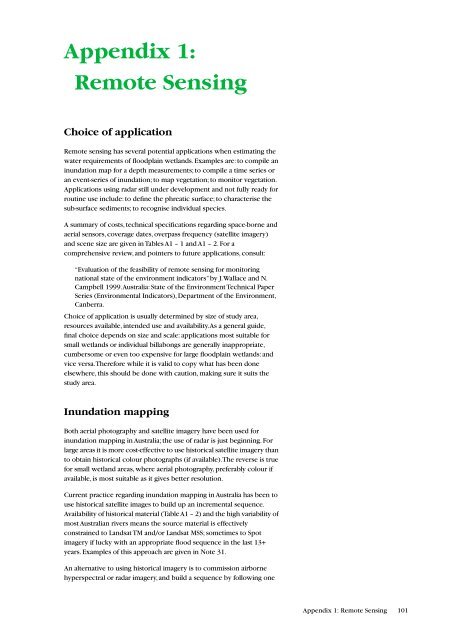Estimating the Water Requirements for Plants of Floodplain Wetlands
Estimating the Water Requirements for Plants of Floodplain Wetlands
Estimating the Water Requirements for Plants of Floodplain Wetlands
You also want an ePaper? Increase the reach of your titles
YUMPU automatically turns print PDFs into web optimized ePapers that Google loves.
Appendix 1:Remote SensingChoice <strong>of</strong> applicationRemote sensing has several potential applications when estimating <strong>the</strong>water requirements <strong>of</strong> floodplain wetlands. Examples are: to compile aninundation map <strong>for</strong> a depth measurements; to compile a time series oran event-series <strong>of</strong> inundation; to map vegetation; to monitor vegetation.Applications using radar still under development and not fully ready <strong>for</strong>routine use include: to define <strong>the</strong> phreatic surface; to characterise <strong>the</strong>sub-surface sediments; to recognise individual species.A summary <strong>of</strong> costs, technical specifications regarding space-borne andaerial sensors, coverage dates, overpass frequency (satellite imagery)and scene size are given in Tables A1 – 1 and A1 – 2. For acomprehensive review, and pointers to future applications, consult:“Evaluation <strong>of</strong> <strong>the</strong> feasibility <strong>of</strong> remote sensing <strong>for</strong> monitoringnational state <strong>of</strong> <strong>the</strong> environment indicators” by J. Wallace and N.Campbell 1999. Australia: State <strong>of</strong> <strong>the</strong> Environment Technical PaperSeries (Environmental Indicators), Department <strong>of</strong> <strong>the</strong> Environment,Canberra.Choice <strong>of</strong> application is usually determined by size <strong>of</strong> study area,resources available, intended use and availability. As a general guide,final choice depends on size and scale: applications most suitable <strong>for</strong>small wetlands or individual billabongs are generally inappropriate,cumbersome or even too expensive <strong>for</strong> large floodplain wetlands: andvice versa. There<strong>for</strong>e while it is valid to copy what has been doneelsewhere, this should be done with caution, making sure it suits <strong>the</strong>study area.Inundation mappingBoth aerial photography and satellite imagery have been used <strong>for</strong>inundation mapping in Australia; <strong>the</strong> use <strong>of</strong> radar is just beginning. Forlarge areas it is more cost-effective to use historical satellite imagery thanto obtain historical colour photographs (if available). The reverse is true<strong>for</strong> small wetland areas, where aerial photography, preferably colour ifavailable, is most suitable as it gives better resolution.Current practice regarding inundation mapping in Australia has been touse historical satellite images to build up an incremental sequence.Availability <strong>of</strong> historical material (Table A1 – 2) and <strong>the</strong> high variability <strong>of</strong>most Australian rivers means <strong>the</strong> source material is effectivelyconstrained to Landsat TM and/or Landsat MSS; sometimes to Spotimagery if lucky with an appropriate flood sequence in <strong>the</strong> last 13+years. Examples <strong>of</strong> this approach are given in Note 31.An alternative to using historical imagery is to commission airbornehyperspectral or radar imagery, and build a sequence by following oneAppendix 1: Remote Sensing 101
















